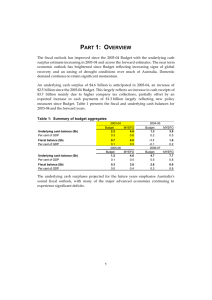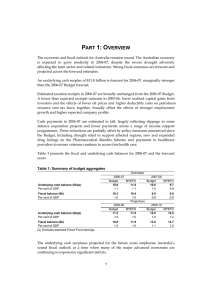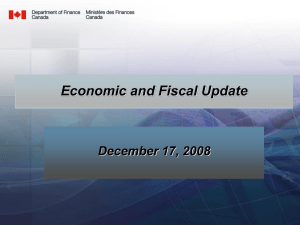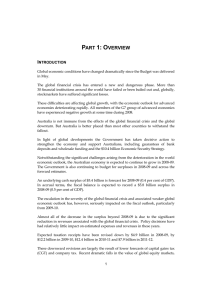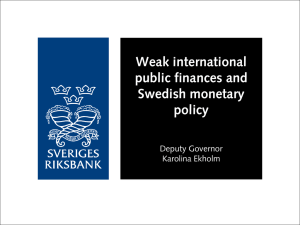P 1: O
advertisement
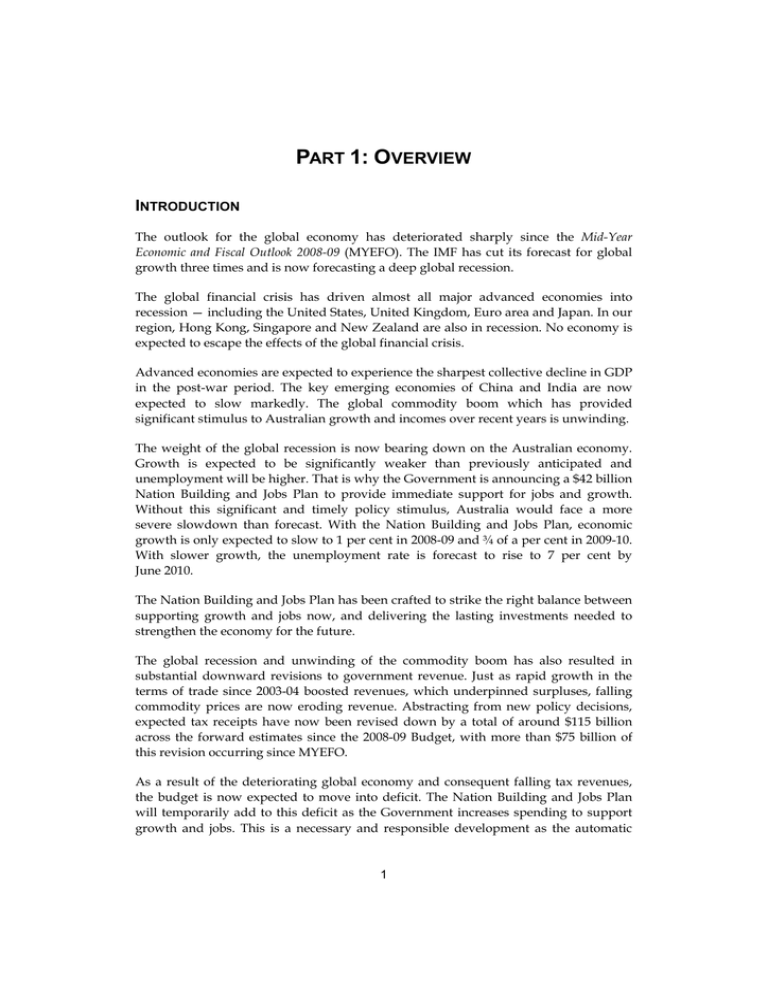
PART 1: OVERVIEW INTRODUCTION The outlook for the global economy has deteriorated sharply since the Mid-Year Economic and Fiscal Outlook 2008-09 (MYEFO). The IMF has cut its forecast for global growth three times and is now forecasting a deep global recession. The global financial crisis has driven almost all major advanced economies into recession — including the United States, United Kingdom, Euro area and Japan. In our region, Hong Kong, Singapore and New Zealand are also in recession. No economy is expected to escape the effects of the global financial crisis. Advanced economies are expected to experience the sharpest collective decline in GDP in the post-war period. The key emerging economies of China and India are now expected to slow markedly. The global commodity boom which has provided significant stimulus to Australian growth and incomes over recent years is unwinding. The weight of the global recession is now bearing down on the Australian economy. Growth is expected to be significantly weaker than previously anticipated and unemployment will be higher. That is why the Government is announcing a $42 billion Nation Building and Jobs Plan to provide immediate support for jobs and growth. Without this significant and timely policy stimulus, Australia would face a more severe slowdown than forecast. With the Nation Building and Jobs Plan, economic growth is only expected to slow to 1 per cent in 2008-09 and ¾ of a per cent in 2009-10. With slower growth, the unemployment rate is forecast to rise to 7 per cent by June 2010. The Nation Building and Jobs Plan has been crafted to strike the right balance between supporting growth and jobs now, and delivering the lasting investments needed to strengthen the economy for the future. The global recession and unwinding of the commodity boom has also resulted in substantial downward revisions to government revenue. Just as rapid growth in the terms of trade since 2003-04 boosted revenues, which underpinned surpluses, falling commodity prices are now eroding revenue. Abstracting from new policy decisions, expected tax receipts have now been revised down by a total of around $115 billion across the forward estimates since the 2008-09 Budget, with more than $75 billion of this revision occurring since MYEFO. As a result of the deteriorating global economy and consequent falling tax revenues, the budget is now expected to move into deficit. The Nation Building and Jobs Plan will temporarily add to this deficit as the Government increases spending to support growth and jobs. This is a necessary and responsible development as the automatic 1 Treasury - Updated Economic and Fiscal Outlook - Part 1: Overview stabilisers kick in to help moderate the downturn and the Government leverages its strong balance sheet to support the economy. Importantly, the Nation Building and Jobs Plan does not lock in a permanent increase in government spending. These are exceptional circumstances and fiscal policy must take a strong role in supporting the economy. As a result of a combination of lower revenue and the stimulus package, the underlying cash balance is now forecast to be a deficit of $22.5 billion in 2008-09. The Government’s medium-term fiscal prospects remain sound. As soon as the economy recovers, and grows above trend, the Government will take action to return the budget to surplus. Table 1.1 shows the fiscal and underlying cash balances for 2008-09 and the forward years. Further details on the accrual and cash budget estimates are provided in Part 4: Fiscal strategy and outlook. Table 1.1: Summary of budget aggregates Estimates 2008-09 MYEFO 5.4 0.4 Underlying cash balance ($b)(a) Per cent of GDP Fiscal balance ($b) Per cent of GDP 5.8 0.5 Underlying cash balance ($b)(a) Per cent of GDP Fiscal balance ($b) Per cent of GDP (a) Excludes expected Future Funds earnings. UEFO -22.5 -1.9 -22.4 -1.9 Projections 2009-10 MYEFO 3.6 0.3 UEFO -35.5 -2.9 7.1 0.6 -33.3 -2.8 2010-11 MYEFO 2.6 0.2 UEFO -34.3 -2.7 2011-12 MYEFO 6.7 0.5 UEFO -25.7 -1.9 6.7 0.5 -31.5 -2.5 10.1 0.7 -23.9 -1.8 The Australian Government’s budget remains in a much stronger position than that of most other countries. The underlying cash deficit forecast for 2008-09 of 1.9 per cent of GDP and for 2009-10 of 2.9 per cent of GDP compares to the average deficit of 7 per cent of GDP for advanced economies in 2009 as calculated by the IMF. 2 Chart 1.1: Budgetary position for advanced economies 2006-10 2 Per cent of GDP Per cent of GDP 2 1 1 0 0 -1 -1 -2 -2 -3 -3 -4 -4 -5 -5 -6 -6 -7 -7 -8 -8 2006 2007 2008 Advanced economies 2009 2010 Australia NATION BUILDING AND JOBS PLAN In the face of these extraordinary global conditions, the immediate and overriding priority for fiscal policy must be to support economic growth and jobs. The Government is taking decisive action to strengthen growth and support jobs through a $42 billion Nation Building and Jobs Plan. The Plan will help support and sustain up to 90,000 jobs over the next two years. The economic impact of the Plan is that GDP growth is expected to be around ½ per cent higher in 2008-09 and around ¾ to 1 per cent higher in 2009-10 than it would have been without the Plan. The forecasts are contingent on there being no further deterioration in global economic conditions. Should the global recession significantly worsen, the Government stands ready to take further action. The Nation Building and Jobs Plan delivers a fiscal stimulus package of about 2 per cent of GDP in 2009. The Nation Building and Jobs Plan complements the Government’s $10.4 billion Economic Security Strategy and builds on the long-term reforms agreed by the Council of Australian Governments and the Government’s nation building agenda. The Plan represents a landmark investment of $28.8 billion in schools, housing, energy efficiency, community infrastructure and roads and support to small businesses. 3 Treasury - Updated Economic and Fiscal Outlook - Part 1: Overview • The Building the Education Revolution program will invest $14.7 billion in primary school infrastructure and maintenance, secondary schools maintenance and to bring forward the funding of trade training centres. • $6.6 billion will be allocated to boost the national stock of community housing by 20,000 and for the construction of additional defence housing. • The energy efficiency of Australian homes will be enhanced, contributing to reduced greenhouse gases, through a $3.9 billion program to provide free ceiling insulation for home owners, additional assistance to landlords to install insulation as well as increasing solar hot water rebates for households. • $890 million will be allocated to repair regional roads and black spots, the installation of boom gates at rail crossings and regional and local government infrastructure. • A $2.7 billion Small Business and General Business Tax Break will assist small businesses and other businesses by supporting the bring forward and maintenance of their capital expenditure. This direct investment in the nation’s infrastructure will bring lasting benefits to the economy. The Government will provide $12.7 billion to deliver an immediate stimulus to the economy to support growth and jobs now before investment spending and lower interest rates take effect. These measures include an $8.2 billion Tax Bonus for Working Australians, a $1.4 billion Single-income Family Bonus, a $20.4 million Farmer’s Hardship Bonus, a $2.6 billion Back to School Bonus and a $511 million Training and Learning Bonus. These bonuses will be paid from early March. FISCAL STRATEGY The Government remains committed to its medium-term fiscal strategy of: • achieving budget surpluses, on average, over the economic cycle; • keeping taxation as a share of GDP on average below the level for 2007-08; and • improving the Government’s net financial worth over the medium term. These medium-term fiscal policy objectives anticipate that the Government will support economic growth and jobs by allowing the budget to move into deficit during an economic downturn. 4 To ensure that growth is supported in a way that is consistent with the medium-term fiscal strategy, the Government will: 1. Support the economy: the fiscal strategy for 2008-09 and 2009-10 As Australia enters an economic slowdown of uncertain extent and duration, it is important that the Government continues to support the economy by: • allowing the variations in revenue and expenditure, which are naturally associated with slower economic growth, to drive a temporary underlying cash budget deficit; and • using additional spending to deliver timely, targeted and temporary stimulus, with the clear objective of other budget priorities and new policy proposals being met through a re-prioritisation of existing expenditure. 2. Return the budget to surplus: the fiscal strategy as the economy recovers The Government reaffirms its commitment to achieve budget surpluses, on average, over the economic cycle. As the economy recovers, and grows above trend, the Government will take action to return the budget to surplus by: • allowing the level of tax receipts to recover naturally as the economy improves, while maintaining the Government’s commitment to keep taxation as a share of GDP below the 2007-08 level on average; and • holding real growth in spending to 2 per cent a year until the budget returns to surplus. DOMESTIC AND INTERNATIONAL ECONOMIC OUTLOOK While the global economy has been slowing for some time, it is clear that the world is facing a much deeper and more protracted slowdown than previously anticipated. The effects of the global financial crisis on the real economy have been faster and more pervasive than many previously expected. The world economy is expected to grow by just ½ of one per cent in 2009. Advanced economies are expected to experience the deepest recession since World War II. The key emerging economies of China and India, which are vitally important for Australia’s growth prospects, are now slowing sharply. The weakness in China will be particularly damaging for Australia since China has been the main driver of global growth over the past few years, pushing up commodity 5 Treasury - Updated Economic and Fiscal Outlook - Part 1: Overview prices, driving an investment boom and providing significant stimulus to Australian economic growth and national incomes. Large falls in the terms of trade are now expected, with key commodity prices forecast to reverse much of the gains from recent years. With the global outlook having deteriorated substantially, the outlook for the Australian economy is significantly weaker than at MYEFO. Taking into account the fiscal stimulus measures in the Nation Building and Jobs Plan economic growth is expected to slow to 1 per cent in 2008-09 and ¾ of a per cent in 2009-10. Even with this sobering prognosis, there remain significant downside risks. If the global recession is deeper and more protracted than expected, this would inevitably cause a more severe slowdown in Australia. The global recession will mean higher unemployment in Australia as private sector spending slows. The Nation Building and Jobs Plan will support jobs by boosting household consumption, supporting private sector investment and providing additional public investment spending. To the extent that households save part of their payments and tax bonuses, this will help repair household balance sheets, provide a boost to confidence and support a return to more normal levels of consumption over time. The Plan will help support and sustain up to 90,000 jobs over the next two years. Notwithstanding the solid boost provided by the fiscal stimulus, the unemployment rate is forecast to reach 7 per cent by June 2010. While Australia cannot resist the pull of global economic forces, we are better placed than most other nations to face this global recession. The domestic slowdown is expected to be milder than in most of our major trading partners who are facing sharp contractions in GDP (Chart 1.2). 6 Chart 1.2: Australia and major trading partner GDP growth (2009 forecast) 2 Per cent Per cent 2 1 1 0 0 -1 -1 -2 -2 -3 -3 -4 -4 United States Euro area United Kingdom Japan Korea New Zealand Australia Note: Australia data refer to forecasts for 2009-10. Source: Treasury. Table 1.2 presents the major economic parameters used in preparing the Updated Economic and Fiscal Outlook (UEFO). The parameters for 2008-09 and 2009-10 are forecasts, while those for 2010-11 and 2011-12 are projections. Table 1.2: Main economic parameters(a)(b) Forecasts Projections 2008-09 2009-10 2010-11 2011-12 Real GDP 1 3/4 3 3 Employment 1 - 3/4 1 1/4 1 1/4 Wage price index 4 3 1/2 4 4 CPI 2 2 2 1/2 2 1/2 Nominal GDP 6 3/4 0 5 1/4 5 1/4 (a) All parameters except the CPI are year average percentage changes. The CPI is through the year growth to the June quarter. (b) The forecasts include the fiscal stimulus measures announced at the time of UEFO and assume an interest rate profile in line with market expectations at the time that the forecasts were prepared. The projections of economic growth are based on analysis of underlying trends in employment and productivity. With a sharp fall in key non-rural commodity prices included in the forecasts, the Budget and MYEFO assumption of a further fall in commodity prices during the projection years is no longer appropriate. The projections of inflation are consistent with the medium term target band. 7

